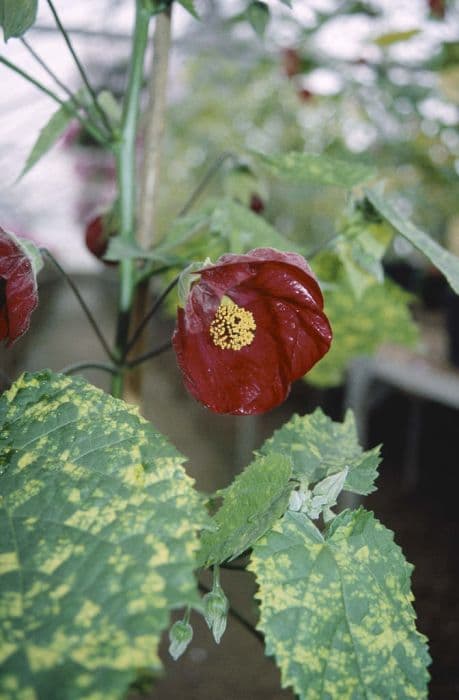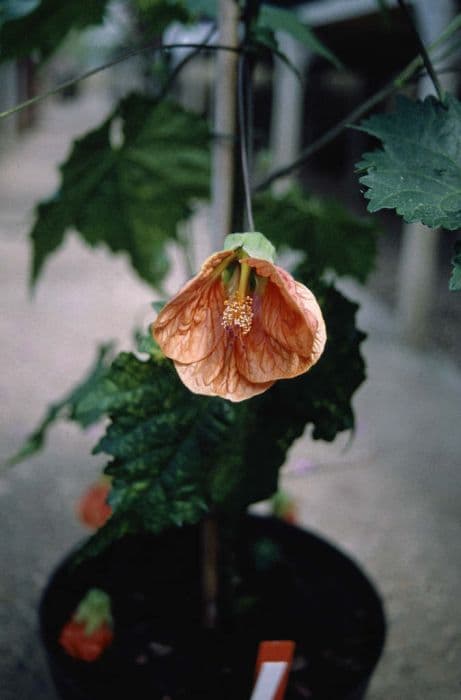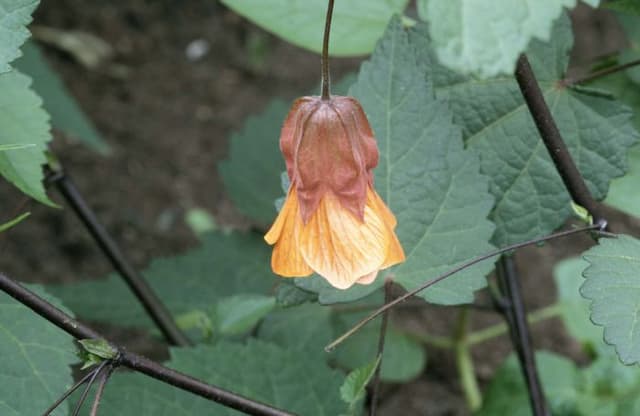Flowering Maple Abutilon 'Julia'

ABOUT
The Abutilon 'Julia', commonly known as the flowering maple 'Julia', is a striking plant known for its unique appearance. Its leaves resemble those of a maple tree, with a rich green color and a somewhat heart-shaped form with pointed tips and serrated edges. The foliage provides a lush and decorative backdrop for the plant's true showstoppers, its flowers. The blossoms of the flowering maple 'Julia' dangle gracefully from the branches, adding a touch of exotic beauty. Typically, the flowers are bell-shaped and exhibit a fetching shade of orange, with yellow streaks or veining adding to their visual appeal. The inside of the bloom often has a deeper shade at the center, giving the flower a lovely depth. These colors can vary slightly depending on the care and environment the plant is in. The overall bearing of the flowering maple 'Julia' is one of gentle elegance, with its blossoms often compared to little colorful lanterns lighting up the foliage. The stems of the plant are somewhat tender, with a green to reddish hue, depending on their maturity and exposure to sunlight. In its cultivated habitat, it presents a neat and compact growth habit, which makes it a beloved choice for ornamental purposes like indoor decoration or as a patio plant. The combination of its maple-like leaves and striking bell-shaped flowers provides a delightful contrast that makes this plant a pleasing visual focal point in any garden or home.
About this plant
 Names
NamesFamily
Malvaceae.
Synonyms
Flowering Maple, Chinese Lantern.
Common names
Abutilon 'Julia'.
 Toxicity
ToxicityTo humans
Abutilon 'Julia', commonly known as flowering maple, is not widely known to be toxic to humans. Ingesting the plant does not typically result in poisoning or serious health consequences. However, it is important to note that individual sensitivities can vary, and consuming plant material that is not typically used for food might cause mild stomach upset or an allergic reaction in sensitive individuals. To err on the side of caution, it is generally best to avoid ingesting ornamental plants.
To pets
Flowering maple is not commonly reported to be toxic to pets such as dogs and cats. There is no well-documented toxicity associated with pets ingesting this plant, and it is generally considered to be of low toxicity. If a pet consumes a large quantity, they might experience some mild gastrointestinal upset, such as vomiting or diarrhea, but serious poisoning is unlikely. As always, monitor your pet for any unusual symptoms and consult a veterinarian if you have concerns.
 Characteristics
CharacteristicsLife cycle
Perennials
Foliage type
Evergreen
Color of leaves
Green
Flower color
Orange
Height
5 feet [1.5 meters]
Spread
3 feet [0.91 meters]
Plant type
Shrub
Hardiness zones
9
Native area
South America
Benefits
 General Benefits
General Benefits- Aesthetic Appeal: Abutilon 'Julia', commonly known as Flowering Maple, has attractive bell-shaped flowers and maple-like leaves, adding visual interest to gardens and indoor spaces.
- Attracts Pollinators: It is known to attract butterflies and hummingbirds, which help in pollination and enhance biodiversity in the garden.
- Adaptability: Flowering Maple can adapt to a range of climates and can be grown indoors as a houseplant or outdoors in milder climates.
- Easy Propagation: The plant can be easily propagated from cuttings, allowing gardeners to create more plants from a single specimen.
- Variety of Uses: It can be used in mixed borders, as a standalone specimen, or in containers, offering versatility in landscaping and interior design.
- Long Blooming Season: Abutilon 'Julia' has a long flowering season, which can provide color and interest for much of the year.
- Minimal Pest Problems: Generally resistant to pests, reducing the need for chemical treatments and making it a low-maintenance option for gardeners.
 Medical Properties
Medical PropertiesThis plant is not used for medical purposes.
 Air-purifying Qualities
Air-purifying QualitiesThis plant is not specifically known for air purifying qualities.
 Other Uses
Other Uses- Abutilon 'Julia', commonly known as Flowering Maple, can be used in mixed containers for patios or balconies due to its attractive bell-shaped flowers and maple-like leaves.
- The plant can be used in butterfly gardens as it is attractive to pollinators and can help support local butterfly populations.
- Flowering Maple can be trained as a bonsai for those interested in the miniature tree hobby, offering a unique challenge due to its fast growth and large leaves.
- The stems of Abutilon 'Julia' can be used in floral arrangements as live or dried elements, adding a unique and tropical flair to bouquets.
- Creative crafters sometimes use the dried seed pods and flowers of the Flowering Maple in creating natural decorative items or jewelry.
- When grown indoors, Flowering Maple can add a splash of color in an indoor plant collection due to its year-round blooming indoors under the right conditions.
- Its leaves can be used as a natural green dye for fabrics, although this use is not common and requires experimentation to perfect the process.
- The bark of Abutilon 'Julia' can be utilized in papermaking as a fibrous material, especially in artisanal papermaking practices.
- The wood from Abutilon 'Julia' is sometimes used for crafting small wooden objects or tools as part of sustainable use practices.
- In educational settings, the plant can be used to demonstrate principles of botany and horticulture, including plant growth, flowering, and pruning techniques.
Interesting Facts
 Feng Shui
Feng ShuiThe Flowering Maple is not used in Feng Shui practice.
 Zodiac Sign Compitability
Zodiac Sign CompitabilityThe Flowering Maple is not used in astrology practice.
 Plant Symbolism
Plant Symbolism- Potential and Promise: The Abutilon 'Julia', commonly known as 'Flowering Maple', often symbolizes potential and promise because it continually blooms, hinting at the unending opportunity for growth and renewal.
- Protection: Its maple-like leaves are thought to provide shelter and protection, symbolizing safety and comfort against life's adversities.
- Subtle Beauty: The delicate bell-shaped flowers of the Flowering Maple represent understated beauty, suggesting grace, femininity, and soft allure.
- Domestic Harmony: As a plant often grown indoors, it is associated with creating a harmonious household and maintaining peace within the family.
 Water
WaterThe Flowering Maple 'Julia' prefers consistently moist soil, so it's essential to water it when the top inch of soil feels dry to the touch. In general, this might mean watering with approximately 16-24 ounces every week during the growing season. However, during hotter periods, it may require more frequent watering to maintain soil moisture. During winter, reduce watering to when the top two inches of soil are dry, which could reduce the need to approximately 16 ounces every two weeks, depending on the indoor conditions and plant size.
 Light
LightThe Flowering Maple 'Julia' thrives best in bright, indirect sunlight. An ideal spot would be near a window that receives plenty of light but is shielded from the harsh direct rays of the afternoon sun. This plant can adapt to medium light conditions but its blooming may be reduced.
 Temperature
TemperatureFlowering Maple 'Julia' does well in temperatures between 60°F and 80°F, which are the typical indoor temperature ranges. It can survive temporarily in temperatures as low as 50°F, but it's important to avoid exposure to temperatures below this as cold drafts can be damaging. The ideal temperature range encourages healthy growth and blooming.
 Pruning
PruningPruning the Flowering Maple 'Julia' enhances its shape and encourages denser foliage. It's best to prune in late winter or early spring before the new growth starts. Remove any dead or damaged branches and trim back as needed to maintain its form. Pruning can be done every year to keep the plant looking its best.
 Cleaning
CleaningAs needed
 Soil
SoilThe Flowering Maple 'Julia' thrives in a well-draining, loamy potting mix augmented with peat and perlite to ensure proper drainage and aeration. The ideal soil pH for this plant ranges between 6.0 to 7.5, slightly acidic to neutral.
 Repotting
RepottingFlowering Maple 'Julia' should be repotted every 2-3 years to refresh the soil and accommodate root growth. It's best to repot in the spring just before the growing season begins.
 Humidity & Misting
Humidity & MistingFlowering Maple 'Julia' prefers moderate to high humidity levels, ideally between 40% and 60%. They benefit from regular misting or a humidity tray to maintain these conditions.
 Suitable locations
Suitable locationsIndoor
Place in bright, indirect light and maintain high humidity.
Outdoor
Grow in partial shade, shelter from strong wind.
Hardiness zone
8-11 USDA
 Life cycle
Life cycleAbutilon 'Julia', commonly known as the Julia Flowering Maple, begins its life as a seed that germinates in warm soil with plenty of sunlight. Upon sprouting, it enters the vegetative stage, where it develops a root system and foliage, growing rapidly with adequate moisture and fertilization. As it matures, the plant initiates the flowering stage, producing bell-shaped flowers that may attract pollinators, which is crucial for the plant's reproduction if it forms viable seeds. After pollination, seeds develop within the fruits, and once mature, they are dispersed to begin a new cycle. The Julia Flowering Maple can be perennial in warmer climates, where it enters a repeated seasonal cycle of growth, flowering, and seed production. In colder regions, it is often treated as an annual, completing its life cycle within one growing season unless it is protected from frost.
 Propogation
PropogationPropogation time
Spring-Summer
The Abutilon 'Julia', commonly known as Flowering Maple, can be propagated through the popular method of softwood cuttings. This technique is ideally performed during the late spring or early summer when the plant's growth is most vigorous. To propagate by cuttings, a healthy, non-flowering shoot is selected, cut at about 4-6 inches (10-15 cm) in length, and the lower leaves are removed. The cut end is then dipped in rooting hormone to encourage root development and planted in a well-drained soil mix. It is essential to maintain high humidity around the cutting by covering it with a plastic bag or placing it in a propagator, and to keep the soil consistently moist but not waterlogged until roots have established, which typically takes a few weeks. Once the cutting has rooted, it can be transferred to a larger pot and gradually acclimatized to less humid conditions before planting out.




![Abutilon [Yellow Trumpet]](/_next/image?url=https%3A%2F%2Fplants-admin.emdemapps.com%2Fimages%2Fplants%2F%2Fimages%2F604b5caa8b4fb.png&w=640&q=75)



